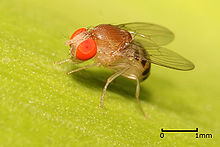The Drosophilinae are the largest subfamily in the Drosophilidae. The other subfamily is the Steganinae.
| Drosophilinae | |
|---|---|

| |
| Drosophila sp. | |
| Scientific classification | |
| Domain: | Eukaryota |
| Kingdom: | Animalia |
| Phylum: | Arthropoda |
| Class: | Insecta |
| Order: | Diptera |
| Family: | Drosophilidae |
| Subfamily: | Drosophilinae Rondani, 1856 |
| Tribes | |
Phylogeny
editMany molecular studies have addressed small parts of the phylogenetic tree. Most of these studies are limited to species of the genus Drosophila. The genus Drosophila is paraphyletic as several genera, such as Zaprionus, Scaptomyza and Lordiphosa, are positioned within the genus. Position of the bolded species in the phylogenetic tree is at least reasonably well supported by existing molecular evidence.[1][2][3][4][5][6][7][8][9][10][11][12][13][14][15][16][17][18][19][20][21][excessive citations]
Tribe: Drosophilini
- Subtribe: Colocasiomyina
- Genus: Baeodrosophila
- Genus: Colocasiomyia
- Genus: Palmomyia
- Genus: Palmophila
- Subtribe: Drosophilina
- Infratribe: Drosophiliti
- Genus: Bialba
- Genus: Calodrosophila
- Genus: Celidosoma
- Genus: Chymomyza
- Genus: Dicladochaeta
- Genus: Hypselothyrea
- Genus: Jeannelopsis
- Genus: Lissocephala
- Genus: Marquesia
- Genus: Microdrosophila
- Genus: Mulgravea
- Genus: Neotanygastrella
- Genus: Paraliodrosophila
- Genus: Poliocephala
- Genus: Protochymomyza
- Genus: Scaptodrosophila
- Genus: Sphaerogastrella
- Genus: Styloptera
- Genus: Tambourella
- Genus: Zaropunis
- Genus: Drosophila including the following genera:
- Genus: Dettopsomyia
- Genus: Dichaetophora
- Genus: Hirtodrosophila
- Genus: Liodrosophila
- Genus: Lordiphosa
- Genus: Mycodrosophila
- Genus: Paramycodrosophila
- Genus: Phorticella
- Genus: Samoaia
- Genus: Scaptomyza
- Genus: Zaprionus[21]
- Genus: Zygothrica
- Infratribe: Laccodrosophiliti
- Genus: Zapriothrica
- Genus: Laccodrosophila
- Infratribe: Drosophiliti
Tribe: Cladochaetini
- Genus: Cladochaeta
- Genus: Diathoneura
Tribe unknown:
For species within the various genera, see Taxodros
References
edit- ^ Beverley, S. M. & A. C. Wilson 1984. Molecular evolution in Drosophila and the higher Diptera. II. A time scale for fly evolution. Journal of Molecular Evolution 21: 1-13.
- ^ Da Lage, J.-L., G. J. Kergoat, F. Maczkowiak, J.-F. Silvain, M.-L. Cariou & D. Lachaise 2007. A phylogeny of Drosophilidae using the Amyrel gene: questioning the Drosophila melanogaster species group boundaries. Journal of Zoological Systematics and Evolutionary Research 45(1): 47-63.
- ^ Davis, T., J. Kurihara, E. Yoshino & D. Yamamoto 2000. Genomic organisation of the neural sex determination gene fruitless (fru) in the Hawaiian species Drosophila silvestris and the conservation of the fru BTB protein-protein-binding domain throughout evolution. Hereditas 132(1): 67-78.
- ^ DeSalle, R. 1992. The phylogenetic relationships of flies in the family Drosophilidae deduced from mtDNA sequences. Molecular Phylogenetics and Evolution 1: 31-40.
- ^ Gailey, D. A., S. K. Ho, S. Ohshima, J. H. Liu, M. Eyassu, M. A. Washington, D. Yamamoto & T. Davis 2000. A phylogeny of the Drosophilidae using the sex-behaviour gene fruitless. Hereditas 133(1): 81-83.
- ^ Hu, Y. G. & M. J. Toda 2001. Polyphyly of Lordiphosa and its relationships in Drosophilinae (Diptera: Drosophilidae). Systematic Entomology 26(1): 15-31.
- ^ Hu, Y.-G. & M. J. Toda 2002. Cladistic analysis of the genus Dichaetophora Duda (Diptera: Drosophilidae) and a revised classification. Insect Systematics and Evolution 33: 91-102.
- ^ Kambysellis, M. P., K. F. Ho, E. M. Craddock, F. Piano, M. Parisi & J. Cohen 1995. Pattern of ecological shifts in the diversification of Hawaiian Drosophila inferred from a molecular phylogeny. Current Biology 5(10): 1129-1139.
- ^ Katoh, T., K. Tamura & T. Aotsuka 2000. Phylogenetic position of the subgenus Lordiphosa of the genus Drosophila (Diptera: Drosophilidae) inferred from alcohol dehydrogenase (Adh) gene sequences. Journal of Molecular Evolution 51(2): 122-130.
- ^ Kwiatowski, J. & F. J. Ayala 1999. Phylogeny of Drosophila and related genera: conflict between molecular and anatomical analyses. Molecular Phylogenetics and Evolution 13(2): 319-328.
- ^ Kwiatowski, J., M. Krawczyk, M. Jaworski, D. Skarecky & F. J. Ayala 1997. Erratic evolution of glycerol-3-phosphate dehydrogenase in Drosophila, Chymomyza, and Ceratitis. Journal of Molecular Evolution 44(1): 9-22.
- ^ Kwiatowski, J., D. Skarecky, K. Bailey & F. J. Ayala 1994. Phylogeny of Drosophila and related genera inferred from the nucleotide sequence of the Cu,Zn Sod gene. Journal of Molecular Evolution 38(5): 443-454.
- ^ Pélandakis, M. & M. Solignac 1993. Molecular phylogeny of Drosophila based on ribosomal RNA sequences. Journal of Molecular Evolution 37(5): 525-543.
- ^ Remsen, J. & R. DeSalle 1998. Character congruence of multiple data partitions and the origin of the Hawaiian Drosophilidae. Molecular Phylogenetics and Evolution 9(2): 225-235.
- ^ Remsen, J. & P. O'Grady 2002. Phylogeny of Drosophilinae (Diptera: Drosophilidae), with comments on combined analysis and character support. Molecular Phylogenetics and Evolution 24(2): 249-264.
- ^ Robe, L. J., V. L. S. Valente, M. Budnik & E. L. S. Loreto 2005. Molecular phylogeny of the subgenus Drosophila (Diptera, Drosophilidae) with an emphasis on Neotropical species and groups: a nuclear versus mitochondrial gene approach. Molecular Phylogenetics and Evolution 36(3): 623-640
- ^ Russo, C. A. M., N. Takezaki & M. Nei 1995. Molecular phylogeny and divergence times of drosophilid species. Molecular Biology and Evolution 12(3): 391-404.
- ^ Tatarenkov, A., J. Kwiatowski, D. Skarecky, E. Barrio & F. J. Ayala 1999. On the evolution of Dopa decarboxylase (Ddc) and Drosophila systematics. Journal of Molecular Evolution 48(4): 445-462.
- ^ Tatarenkov, A., M. Zurovcova & F. J. Ayala 2001. Ddc and sequences resolve phylogenetic relationships of Drosophila. Molecular Phylogenetics and Evolution 20(2): 321-325.
- ^ Thomas, R. H. & J. A. Hunt 1993. Phylogenetic relationships in Drosophila: a conflict between molecular and morphological data. Molecular Biology and Evolution 10(2): 362-374.
- ^ a b Yassin A, Araripe LO, Capy P, Da Lage J-L, Klaczko LB, Maisonhaute C, Ogereau D and David JR (2008) Grafting the molecular phylogenetic tree with morphological branches to reconstruct the evolutionary history of the genus Zaprionus (Diptera: Drosophilidae). Molecular Phylogenetics and Evolution 47:903-915.